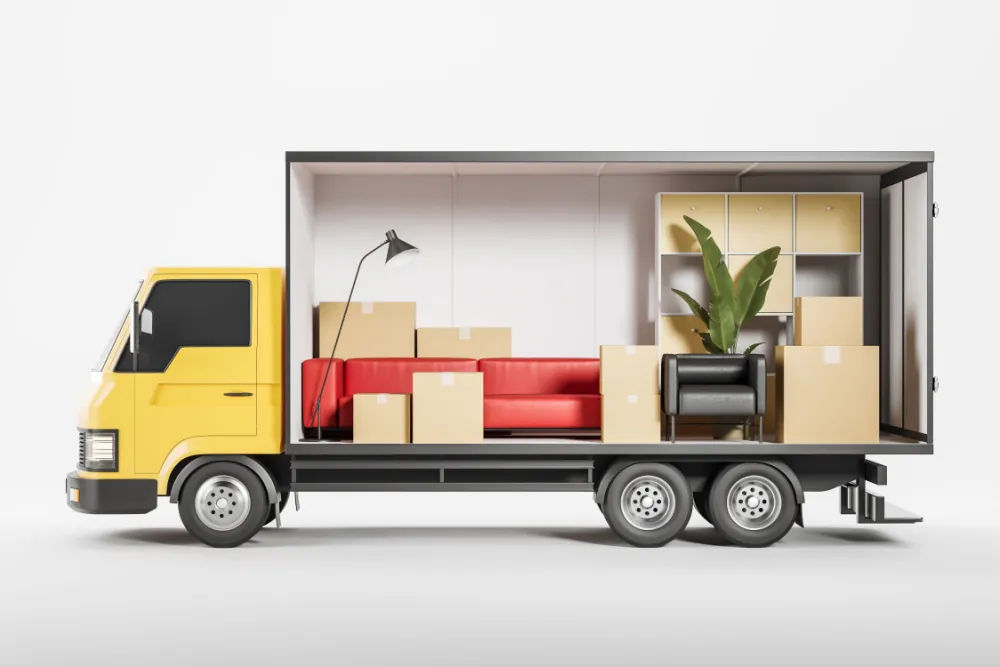Interstate furniture transport tips for small and larger moves – Moving your furniture across state lines can be a daunting task, whether you’re moving from a small one-room studio or a large family home. Without the right preparation, costs can be high, your furniture may get damaged, and anxiety levels can be elevated. The good news is you can have a smooth, easy, and reasonably priced interstate furniture move for any size load, with proper planning. Below are helpful interstate furniture transportation tips, whether you are moving a small load or a larger load, as well as answers to questions we hear most often when people are preparing for their big move.
Table of Contents
Toggle
Evaluate – Declutter before you pack
One of the rules of thumb for any furniture move is: you do not want to move what you do not need. For smaller moves, it might make sense to click donate on your older chairs, side tables, or those items that will not fit your new space. For larger moves, it might mean having a garage sale, or selling that old couch that would cost more to move than buy a new one.
Decluttering will decrease the overall amount of your load, thereby reducing your overall transport costs. Interstate furniture removalists will typically charge either by volume or by weight. Less clutter also means fewer packing materials to pack and unpack.
Measure and Plan for Access Points
Before moving day, be sure to measure all your larger furniture and the access points at both your old and new homes. This is especially important for larger moves with multiple bulky items — beds, sofas, dining tables, and wardrobes can be awkward to move through narrow hallways or stairwells.
For small moves, measuring ahead will help limit any last-minute surprises that leave you disassembling furniture on the doorstep. If you know something won’t fit, you can factor in partial disassembly or even rethink whether it should be moved at all.
Choose the Right Interstate Removalist
Not all removalists are the same, and this is even more critical where interstate furniture transport is concerned. Aim for removalists that have experience with your type of move, some removalists may cater for small single-load backloads, and others focus on full house removals with a truck load or full load.
For small moves, consider backloading. A Backload means that your furniture is sharing truck space with other loads travelling in the same direction, often at a significantly reduced price. For larger moves, book an exclusive truck so that your furniture can be attended to and delivered together on your timeline; that way, you get to control when the truck arrives. Research and read reviews, ask questions about insurance, and most importantly, get multiple quotes so you can compare options.
Pack Furniture Properly
- Packing is where many people fail. Poor packing is responsible for most damage to furniture during interstate moves!
- For any-sized move, use proper packing material for furniture, such as moving blankets, furniture pads, or shrink wrap.
- Disassemble large items, if feasible. Fr example remove the legs from tables, remove headboards from beds, keep screws in labelled bags.
- Wrap delicate surfaces to prevent scratching.
- Use cardboard or foam protectors on corners.
If you’re using a moving company, ask if packing is a service they provide. Sometimes it is worth spending more money to have some peace of mind.
Clearly Label Everything
This tip will be useful for bigger and smaller moves, but it’s especially valuable for large interstate moves with many rooms of furniture. Clearly label pieces of furniture and boxes by room and contents. This will allow the mover to load/unload quickly and accurately to ensure the right furniture is in the correct location in your new home. For smaller moves, clearly labelled boxes will also prevent mix-ups when backloading, which is when your furniture is loaded with someone else’s items.
Know Your Insurance
No matter how careful you or the movers are, things can happen. On a long drive, things can get broken! Before your move, check what your home and/or contents insurance provides.
Numerous moving companies provide transit insurance, but the coverage offered can differ considerably.
If you’re moving valuable or fragile furniture, you may want to add further coverage for potential loss or damage in transit, particularly when moving interstate.
Stage Your Move
Interstate furniture transport costs can go up and down based on the season, and even the day of the week. Peak periods –like long weekends and at the end of the month- are typically more expensive.
Where possible, plan your move for an off-peak period. For smaller loads, you schedule your move flexibly by backloading when there is spare room on a truck, often at a cheaper rate.
Prepare for Delivery
When your furniture is on the road, it’s time to prepare your new home for the delivery of your furniture:
Clear access paths, so movers can carry your furniture inside.
Place protective sheets down so you do not scuff your floors.
Have a plan in place for where large pieces of furniture will go – moving heavy items multiple times is not enjoyable.
For larger moves, you might put together a simple floor plan to help guide the movers.
Conclusion
Whether you’re moving a few sentimental items to another state or an entire household, these interstate furniture transport tips for smaller and bigger moves will help you save money, protect your furniture, and eliminate the stress of moving days. Complete planning, smart packing, and selecting the right moving company are the keys to making your move as smooth as possible. By spending a little extra time upfront, you will thank yourself when you are settled into your new home with your furniture safe and sound.
FAQs
What is the affordable way to move a small amount of furniture interstate?
The most affordable option is frequently backloading. This means your furniture shares truck space with other loads, lowering your cost. Just ensure you pack goods securely and label everything clearly.
How much in advance should I book an interstate furniture removalist?
For larger moves, aim to book at least 6 to 87 weeks in advance, specifically during busy seasons. For small moves or backloads, 2 to 4 weeks may be sufficient, but more notice mainly means better rates.
How can I protect my furniture during an interstate move?
Use quality packing materials, disassemble large items when possible, and protect corners and delicate surfaces. If you are unsure, professional packing services are worth considering to protect your furniture.




